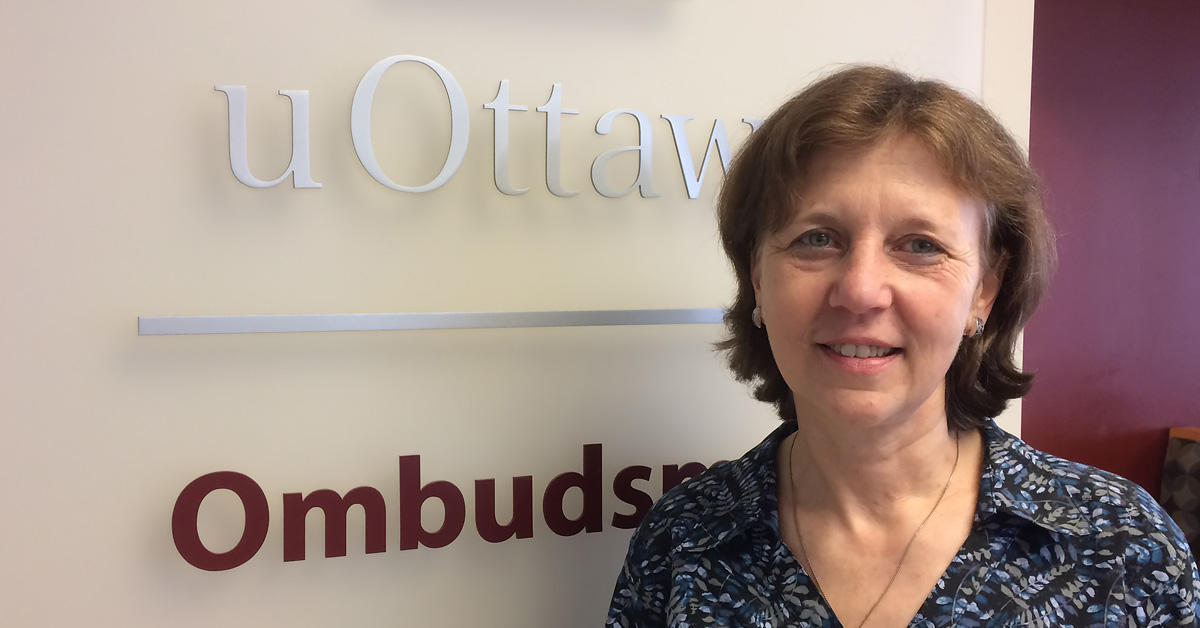By Mike Foster
You’ve gone through all the regular channels to resolve a dispute but still feel you’ve been treated unfairly. Who you gonna call?
The Office of the Ombudsperson is a good place to turn for impartial, confidential and independent advice. Set up in 2010, the ombudsperson is like a watchdog, a referee and a safety net for the University community.
On April 9, the University of Ottawa welcomed a new ombudsperson, Martine Conway, who held the same role at the University of Victoria, in British Columbia, from 1999 to 2018.
Conway sees the ombudsperson as a bridge between students, professors, staff and other members of the University community, on the one hand, and the University’s policies and procedures.
“The ombudsperson is a commitment to fairness. The office is structured to be independent. The ombudsperson is the person that people can go to when they either don’t know where else to go, or feel they haven’t been heard by regular channels. It is, in that sense, a safety net.” – Martine Conway.
Here’s a quick rundown of 9 things you need to know about the Office of the Ombudsperson.
1. The ombudsperson is there to listen and empower
“A big part of the role involves listening to the person who contacts the office, understanding the situation and helping them to identify options for resolving their problem. In many cases, we give them the tools to go and resolve the problem themselves. What is really rewarding is when you’re working with a student who doesn’t know that they have rights or who doesn’t know how to approach the relevant person or unit. They might think nothing can be done but then discover through the office that they do have recourses and how to access them.” – Martine Conway.
2. It’s the ultimate democratic tool
Anybody within the University community can use the service. This includes students at all levels, applicants for admission, alumni, professors, fellows, affiliated researchers and staff, including administrators.
“The ombudsperson can intervene to help clarify information, to help resolve problems informally and to mediate. If a student has exhausted all recourses, the ombudsperson can investigate and may make recommendations to the relevant University decision-makers. The ombudsperson can also recommend improvements to policies and procedures.” – Martine Conway.
3. It’s free! And bilingual!
There’s no charge to use all of these services, and you can do so in either English or French.
4. It’s flexible and responsive
Last year, the office handled 776 different types of issues, ranging from concerns about academic supervision, admission and registration to financial problems, interpersonal disputes and human rights. However, matters that fall under employee collective agreements are not within the ombudsperson’s mandate.
5. It’s totally independent
The office is funded by the University, SFUO and GSAÉD. The ombudsperson operates independently of existing University and student administrative structures.
6. What’s said to the ombudsperson, stays with the ombudsperson
“Because people come to the ombudsperson’s office knowing that the communication with the office is confidential, they can share their story in detail, knowing that it won’t be repeated without their permission in writing.” – Martine Conway.
7. It has a great work rate
The number of cases the office deals with each year has grown. Last year, the office closed 677 files, compared to 174 files closed in its first year. Every year, most of the ombudsperson’s work involves issues raised by students. The office helped 402 students last year.
8. It’s transparent
The ombudsperson submits an annual report to the uOttawa Senate, the Board of Governors and the student associations. You can consult its annual reports and recommendations.
9. It offers clear information
You can find out more by checking out these useful tools produced by the Office of the Ombudsperson on how to handle complaints and how to make a complaint, as well as these FAQs.
